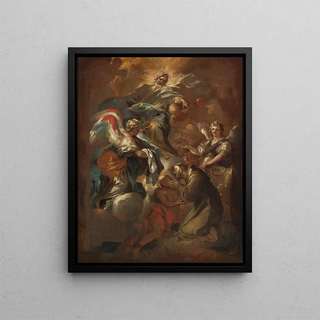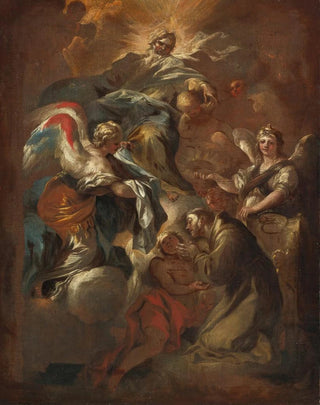Art print | Saint François refuse le sacerdoce A. Bozzetto - Francesco Solimena


View from behind

Frame (optional)
In the fascinating world of baroque art, the art print "Saint François refuse le sacerdoce A. Bozzetto" by Francesco Solimena stands out for its emotional depth and narrative richness. This poignant depiction of Saint Francis of Assisi, renowned for his love of nature and spiritual devotion, evokes a decisive moment in his life. The choice to renounce an ecclesiastical career in favor of a life of poverty and service is illustrated with an intensity that captures the viewer's attention. The scene, imbued with spirituality, transports us into an inner dialogue where faith and humility intertwine, revealing the complexity of the character and his commitment to Christian ideals.
Style and uniqueness of the work
Solimena's technical mastery is evident through the bold use of light and shadow, typical of baroque style. The striking contrasts between illuminated areas and deep shadows create a dramatic atmosphere, emphasizing the intensity of the emotions felt by the saint. The meticulous details of the clothing, facial expressions, and gestures of the characters demonstrate great skill in depicting human feelings. The composition, carefully orchestrated, guides the viewer's gaze across the scene, allowing for full immersion in this moment of reflection and renunciation. The color palette, rich and warm, contributes to the visual impact of the art print, making palpable the spirituality emanating from this iconic representation.
The artist and his influence
Francesco Solimena, an emblematic figure of Neapolitan baroque, established himself as a master of his era through his ability to fuse emotion and technique. Trained in a fertile artistic environment, he was influenced by masters such as Caravaggio, whose use of chiaroscuro shaped his own style. Solimena also integrated elements of classical tradition, enriching his works with an intellectual dimension. His impact on baroque art is undeniable, both through the quality of his creations and his role in shaping generations of artists.

Matte finish

View from behind

Frame (optional)
In the fascinating world of baroque art, the art print "Saint François refuse le sacerdoce A. Bozzetto" by Francesco Solimena stands out for its emotional depth and narrative richness. This poignant depiction of Saint Francis of Assisi, renowned for his love of nature and spiritual devotion, evokes a decisive moment in his life. The choice to renounce an ecclesiastical career in favor of a life of poverty and service is illustrated with an intensity that captures the viewer's attention. The scene, imbued with spirituality, transports us into an inner dialogue where faith and humility intertwine, revealing the complexity of the character and his commitment to Christian ideals.
Style and uniqueness of the work
Solimena's technical mastery is evident through the bold use of light and shadow, typical of baroque style. The striking contrasts between illuminated areas and deep shadows create a dramatic atmosphere, emphasizing the intensity of the emotions felt by the saint. The meticulous details of the clothing, facial expressions, and gestures of the characters demonstrate great skill in depicting human feelings. The composition, carefully orchestrated, guides the viewer's gaze across the scene, allowing for full immersion in this moment of reflection and renunciation. The color palette, rich and warm, contributes to the visual impact of the art print, making palpable the spirituality emanating from this iconic representation.
The artist and his influence
Francesco Solimena, an emblematic figure of Neapolitan baroque, established himself as a master of his era through his ability to fuse emotion and technique. Trained in a fertile artistic environment, he was influenced by masters such as Caravaggio, whose use of chiaroscuro shaped his own style. Solimena also integrated elements of classical tradition, enriching his works with an intellectual dimension. His impact on baroque art is undeniable, both through the quality of his creations and his role in shaping generations of artists.






